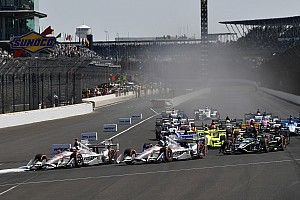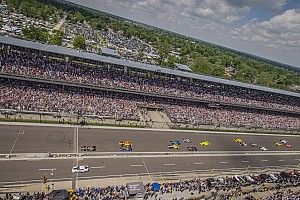IRL: Herb Porter Story
HERBIE HORSEPOWER'S ENGINE STILL REVVING AT AGE 83 INDIANAPOLIS, April 9, 1998 -- Motor meister Herb Porter doesn't know who dubbed him "Herbie Horsepower," or when it happened. "It came out of nowhere," he said. ...

HERBIE HORSEPOWER'S ENGINE STILL REVVING AT AGE 83
INDIANAPOLIS, April 9, 1998 -- Motor meister Herb Porter doesn't know who dubbed him "Herbie Horsepower," or when it happened.
"It came out of nowhere," he said.
Today, Porter is a crusty 83 years old, but the sobriquet still fits. The 82nd Indianapolis 500 this May will mark more than a half-century that Porter has made racing engines go fast at the Indianapolis Motor Speedway.
"I'm married to the engine and that joint (Speedway) over there," said the life-long bachelor between chomps on his cigar at his Speedway Engine Development, Inc. office, located about 2 miles south of the Indianapolis Motor Speedway.
Porter and partner Rick Long still tackle the tough problems involved with perfecting racing engines. Currently, they are preparing Oldsmobile Aurora V8 engines for teams fielding cars in this year's 500 for drivers Stephan Gregoire, Buddy Lazier, Scott Goodyear, Roberto Guerrero, Davey Hamilton and John Paul Jr.
"That's a handful," Porter said.
For many years, Porter developed engines for Goodyear Tire & Rubber Company. The shop he and Long now own has all of the modern computerized equipment, including a dynamometer. The latest addition to Porter's "toys" is a $7,500 machine that measures electrical engine outputs. Porter says it provides information that enables him to check things he's wanted to do for 10 years.
"It wasn't built yet," he said.
Porter has been working closely with Ed Keating at Oldsmobile. He points out how far the Aurora engine has come since its first race at Orlando, Fla., in January 1997 and noted that the teams have lost only one engine in a race this year.
"They've never had a normally aspirated engine run as fast as these, and there's another barrel of snakes," he exclaimed.
Solving engine problems is what keeps him functioning long past retirement time. Listen to him talk to a customer on the phone, and you'll realize how sharp he is mentally. He rattles off minute bearing variances likes they where his home address and discusses the inside of an engine like it was the Taj Mahal. He attacks a tough problem with the vigor of a 30-year-old.
"Don't tell me I can't," he says. "That pisses me off."
Please excuse the language, but Herbie Horsepower can also toss out some pretty forceful words, too.
About four-time Indianapolis 500 winner A.J. Foyt: "We still call each other SOB's. But he listens to me, and I listen to him."
Herbie Horsepower was born in Fort Worth, Texas, and reared in the railroad town of Parsons, Kan. It was racing's good fortune that the parents of pre-World War II Indy 500 driver George Barringer also lived in the same small community in the southeast corner of the state. When Porter, who already had decided he didn't want to work for the railroad like his father did, was in ninth grade, Barringer came from the West Coast for a visit.
"I got on my bicycle and rode over to where they were; they had a garage," he said. "He had a Model T with a double overhead cam engine with five main bearings. It run like hell."
Porter was hooked. He took vocational training in auto mechanics for four hours a day at school. He said he liked working with engines from the beginning. Both his stepfather and cousin were mechanics, and he pored over their instructional books.
Then in 1933 he hopped on his motorcycle and rode to Indy to see his first 500, won by Louie Meyer. He paid $1 for a seat in the fourth turn.
Out of school, he moved to California. He saw an ad for a midget race at old Gilmore Stadium and headed out there, paying 40 cents to get in. There he became acquainted with Bill Mossman, builder for driver Ronney Householder. He helped out on the car and in 1938 started to work for him. The next year he came to the Speedway for the first time in a professional capacity with Leon Duray.
"It was a chance to learn what was going on," Porter said.
World War II took Porter away from racing for six years, but he was totally involved with B-29 bomber engines as a flight engineer while developing a true passion for flying. He and Householder were reunited while campaigning midgets after peace returned. In 1948, Porter took a midget engine and turned it into a sprint car by adding a supercharger. The car won the final race of the season at Salem Speedway.
Porter returned to California and built injectors for engines. His car at Gardena Speedway lapped everyone below third place in 1949. By 1950 he was again at the Speedway working on a Maserati engine owned by Louie Meyer. For a number of years he continued to develop the supercharger.
"I like supercharged engines to this day," he said.
In the early 1960s his work with an Air Research engine impressed both Foyt and Goodyear during tests at Phoenix. He latched up with Don Branson and then in 1966 Bobby Grim drove his Watson Roadster at Indy. He said the team was making a living, and he was gaining experience.
Porter's big break came in 1968 when he prepared the engine for mechanic Jud Phillips and driver Bobby Unser.
"We kicked the turbine's a--, and Bobby won the race," Porter exclaimed, referring to the unique turbine engine that powered Andy Granatelli-owned cars driven by Art Pollard and Joe Leonard.
It was then that Goodyear approached Porter about becoming its engine development man. He worked with Bobby Unser, and the McLarens of Peter Revson and Mark Donohue. Johnny Rutherford later replaced Revson after he was killed in a Formula One crash.
"I got the first turbo Cosworth Goodyear put together," he said. "I learned a lot. As long as we run the Offy (Offenhauser engine) nobody beat me."
Then he put his mind to a Ford and punched up its horsepower enough that Foyt was able to win his fourth and final 500 in 1977. He and Long opened their engine shop after the Ilmor Chevrolet was introduced by Roger Penske in the 1980s, and all development and overhauls were done at the factory. Porter refers to this period as when he was put out of business.
"I've always been a student of theory," he said. "Sometimes I was in front, and I didn't know it. We didn't have any way to check it except on the racetrack. State-of-the-art equipment I love."
Porter's favorite engine was an Olds Quad-Four that Foyt drove at Texas to a then-world speed record. And his favorite moment was Bobby Unser's '68 victory.
"People said you can't do this, you can't do that," he said. "Bobby lost the gearshift lever, and we went out of the pit in high gear two or three times and won the race. That really satisfied me. That got it done when everybody said you can't do it.
"I've just been an engine man since I was a kid. What makes them go, what are their problems? When you beat (the other teams) you get satisfaction. That's what keeps your ego up."
Porter, who needs an electrical cart (unsupercharged) to get around at racetracks, admits his body is "pretty shot" but says his head is "still good." He hasn't reached the rev limiter of life yet and isn't considering retirement.
"I could financially," he said. "What would I do? Sit in a rocking chair until I die? That ain't Porter."
That's why they still call him Herbie Horsepower.
Be part of Motorsport community
Join the conversationShare Or Save This Story
Subscribe and access Motorsport.com with your ad-blocker.
From Formula 1 to MotoGP we report straight from the paddock because we love our sport, just like you. In order to keep delivering our expert journalism, our website uses advertising. Still, we want to give you the opportunity to enjoy an ad-free and tracker-free website and to continue using your adblocker.















Top Comments